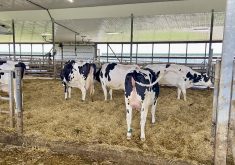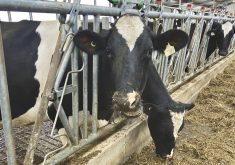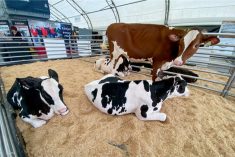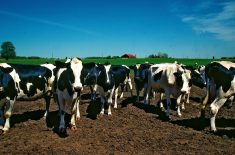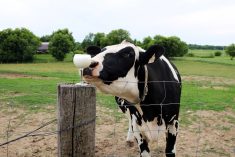Ontario dairy producers are still constructing robot rooms around their automated milking equipment, even though it’s no longer a requirement.
Revisions to the National Automatic Milking Systems Guidelines, put together by the Canadian government and dairy industry representatives in 2020, no longer necessitates milking equipment areas, such as stationary automated milking systems, to have positive air pressure within the area of the milking equipment.
Why it matters: Eliminating a dairy robot room can reduce cost and improve barn air circulation, but provides less protection for the robot operations, especially from cold.
Read Also

BinSentry sensors reduce feed-bin outages
BinSentry sensors mean fewer feed bin outages and more efficient deliver for feed mills.
The trend to mechanically ventilated freestall dairy barns is also driving interest in eliminating robot rooms because they impede airflow.
“(Previously), pressurized systems were needed to have (clean) air pumping into the robot rooms,” says Tristan Hohl, project manager with Lely Center Woodstock, requiring producers to build an enclosed area around their milking equipment to meet that criteria.
Now that requirement has been eliminated, it is opening up new options for dairy farms in their milking areas.
The guidelines were reviewed industry-wide to better streamline tie-stall and stationary robots together, says Hohl.
Producers and industry members have learned over time what is necessary for robotic milking equipment.
“This is the first major update of rules and regulations since robots (were first introduced to Canada.”
Although these changes have brought options for dairy producers across the country, farmers are still including robot rooms in their facilities.
“Based on the climate here in Ontario, it’s typically colder in the winter. We know how challenging that is with cold weather and water, how it likes to freeze. (As well), it’s a nice idea to have a roof on there, you don’t have as much dust,” says Hohl.
Colder winters and the ability to keep the facilitiesclean are the main reasons for having a separate room.
Hohl says in some facilities he even recommends building an enclosure, especially in older style barns with open truss structure or in ones that are not as well insulated as its difficult to heat a room without a roof.
Jason French, volunteer milking systems solutions manager with Delaval North America, says he has noticed a trend in producers’ decisions about robot rooms.
“If it’s a facility where we are confident it is a safe zone, all the equipment is going to work, we don’t require a robot room – (usually) manually ventilated barns, that’s where we are not having the robot rooms,” says French. “In naturally ventilated barns, which could be a touch cooler, a little harder to control the temperature, we still tend to put in the robot rooms.”
Barns without robot rooms tend to have better air movement throughout.
“Probably the biggest benefit, if you have a thermal-ventilated barn, you no longer have a nine- or 10-foot wall impeding the air from flowing through the barn. Even for a naturally ventilated barn, it still works as a wind block,” says Hohl.
Cost is another factor. Walls around the milking equipment area can be four or five feet tall, compared to the nine or 10 feet in an enclosed facility.
French says not having a robot room also provides better sightlines of the robot from all areas of the dairy barn.
French says that of the facilities DeLaval has been involved with since 2018, 20 per cent have decided not to construct a robot room. He is seeing the trend away from rooms in Western Canada. “A lot of barns, especially in Manitoba where they have this kind of manually ventilated barns, they are not putting in a robot room,” says French.
Lely Center Woodstock has yet to install a robot into a facility without an enclosed room, but Hohl says it’s still early since regulatory changes were made.
“One hundred per cent of our customers are still putting up a robot room. It’s only February and they changed it last August. I think we will start to see possibly more changes coming up in the future.”
“It’s a real decision of the owner and the supplier to really determine if it’s the right call to have no robot room. It’s not going to be a thing that everybody does, but if it’s the right decision it still works well,” says French.





